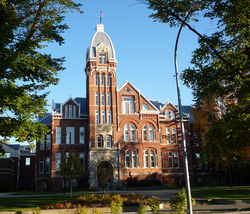Ellensburg, Washington | |
|---|---|
 The historic Davidson Building, completed in 1890 | |
 Location of Ellensburg, Washington | |
| Coordinates: 47°00′01″N120°32′48″W / 47.00028°N 120.54667°W | |
| Country | United States |
| State | Washington |
| County | Kittitas |
| Incorporated | November 26, 1883 |
| Government | |
| • Type | Council–manager |
| • Mayor | Rich Elliott [1] |
| • City Manager | Heidi Behrends Cerniwey |
| Area | |
| 8.43 sq mi (21.83 km2) | |
| • Land | 8.32 sq mi (21.55 km2) |
| • Water | 0.10 sq mi (0.27 km2) |
| Elevation | 1,565 ft (477 m) |
| Population | |
| 18,666 | |
| 18,703 | |
| • Density | 2,248/sq mi (867.9/km2) |
| • Urban | 21,518 |
| • Urban density | 2,434/sq mi (939.9/km2) |
| • Metro | 45,189 (US: 266th) |
| • Metro density | 19,670/sq mi (7,595/km2) |
| Time zone | UTC–8 (Pacific (PST)) |
| • Summer (DST) | UTC–7 (PDT) |
| ZIP Code | 98926 |
| Area code | 509 |
| FIPS code | 53-21240 |
| GNIS feature ID | 2410430 [3] |
| Website | ci.ellensburg.wa.us |
Ellensburg is a city in and the county seat of Kittitas County, Washington, United States. It is located just east of the Cascade Range near the junction of Interstate 90 and Interstate 82. The population was 18,666 at the 2020 census. [4] and was estimated to be 18,703 in 2022. [5]
Contents
- History
- Geography
- Climate
- Economy
- Demographics
- 2020 census
- 2010 census
- 2000 census
- Arts and culture
- Events
- Government and politics
- Media
- Education
- Higher education
- Public schools
- Infrastructure
- Transportation
- Notable people
- References
- Further reading
- External links
The city is located along the Yakima River in the Kittitas Valley, an agricultural region that extends east towards the Columbia River. The valley is a major producer of timothy hay, which is processed and shipped internationally. Ellensburg is also the home of Central Washington University (CWU).
Ellensburg, originally named Ellensburgh for the wife of town founder John Alden Shoudy, was founded in 1871 and grew rapidly in the 1880s following the arrival of the Northern Pacific Railway. The city was once a leading candidate to become the state capital of Washington, but its campaign was scuppered by a major fire in 1889.


